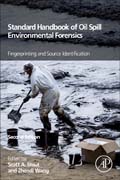
Standard Handbook Oil Spill Environmental Forensics: Fingerprinting and Source Identification
Stout, Scott
Wang, Zhendi
Standard Handbook Oil Spill Environmental Forensics: Fingerprinting and Source Identification, Second Edition, provides users with the latest information on the tools and methods that have become popular over the past ten years. The book presents practitioners with the latest environmental forensics techniques and best practices for quickly identifying the sources of spills, how to form an effective response, and how to determine liability. This second edition represents a complete overhaul of the existing chapters, and includes 13 new chapters on methods and applications, such as emerging application of PAHi isomers in oil spill forensics, development and application of computerized oil spill identification (COSI), and fingerprinting of oil in biological and passive sampling devices. Contains 13 new chapters on methods and applications, including emerging application of PAH isomers in oil drill forensics, the development and application of computerized oil spill identification (COSI), and the fingerprinting of oil in biological and passive sampling devicesPresents the latest technology and methods in biodegradation of oil hydrocarbons and its implications for source identification, surface trajectory modeling of marine oil spills, and identification of hydrocarbons in biological samples for source determinationContains new case studies to illustrate key applications, methods, and techniques INDICE: Part One: IntroductionChapter 1: Chemical Fingerprinting of Spilled or Discharged Petroleum - Methods and Factors Affecting Petroleum Fingerprints in the EnvironmentChapter 2: Spill Site Investigation in Environmental Forensic InvestigationChapter 3: Sampling Procedures for Securing of Evidence for Oil IdentificationPart Two: Targets Chapter 4: Petroleum Biomarker Fingerprinting for Oil Spill Characterization and Source IdentificationChapter 5: Emerging Application of PAH Isomers in Oil Spill ForensicsChapter 6: Characterization of Polycyclic Aromatic Sulfur Heterocycles for Source IdentificationChapter 7: Fingerprinting of Naphthenic Acids in OilPart Three: Methods Chapter 8: Oil Spill Identification by Comprehensive Two-Dimensional Gas Chromatography (GCxGC)Chapter 9: Application of High Resolution Fourier transform ion cyclotron resonance MS (FT ICR MS) in Oil Spill FingerprintingChapter 10: Q-TOF MS development and applications in oil spill studyChapter 11: Application of Stable Isotope Ratios in Spilled Oil IdentificationChapter 12: Spectroscopic Techniques in Oil Spill IdentificationPart Four: ChemistryChapter 13: Gasoline and Distillate Fuel FingerprintingChapter 14: Biodiesel Fuel FingerprintingChapter 15: Chemical Heterogeneity of Marine Heavy Fuel Oils and LubricantsPart Five: ProtocolsChapter 16: CEN Methodology for Oil Spill IdentificationChapter 17: Development and Application of Computerized Oil Spill Identification (COSI)Chapter 18: Multivariate Approach to Oil Hydrocarbon Fingerprinting and Spill Source Chapter 19: Advantages of Quantitative Chemical Fingerprinting in Oil Spill Source IdentificationChapter 20: Statistical Analysis of Oil Spill Fingerprinting DataPart Six: FateChapter 21: Biodegradation of Oil Hydrocarbons and Its Implications for Source IdentificationChapter 22: Photochemical Effects on Oil Spill FingerprintingChapter 23: Oil Spill Remote Sensing : A Forensics ApproachChapter 24: Water Column Oil Tracking and FingerprintingChapter 25: Surface Trajectory Modeling of Marine Oil SpillsChapter 26: Identification of Hydrocarbons in Biological Samples for Source DeterminationChapter 27: Fingerprinting of Oil in Biological and Passive Sampling Devices
- ISBN: 978-0-12-803832-1
- Editorial: Academic Press
- Encuadernacion: Rústica
- Páginas: 1016
- Fecha Publicación: 01/01/2016
- Nº Volúmenes: 1
- Idioma: Inglés
